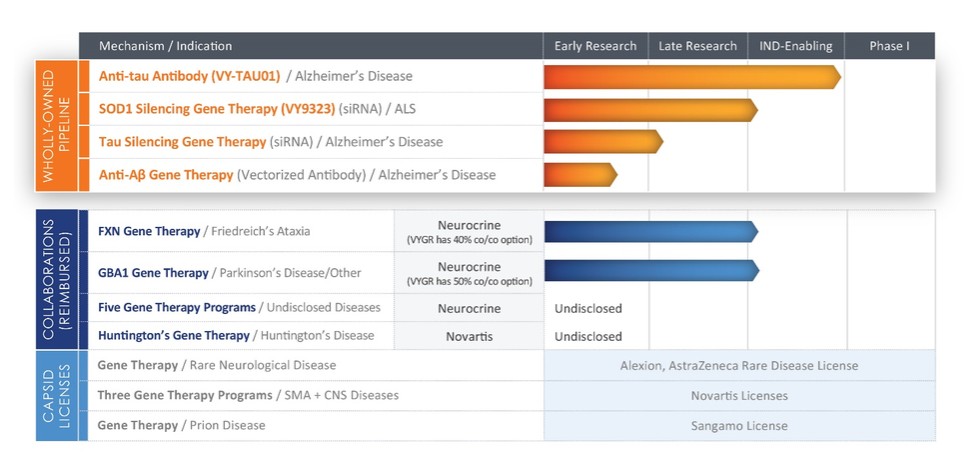product candidates, comprising such TRACER Capsids and payloads intended for the treatment of spinal muscular atrophy, or the Novartis SMA Program, and (b) collaborate to develop AAV gene therapy products and product candidates under the Novartis HD Program, in each case, leveraging TRACER Capsids and other intellectual property controlled by us.
Under the 2023 Novartis Collaboration Agreement, Novartis paid us an upfront payment of $80.0 million. We are eligible to receive specified development, regulatory, and commercialization milestone payments of up to an aggregate of $200.0 million for the Novartis SMA Program and up to an aggregate of $225.0 million for the Novartis HD Program, in each case for the first corresponding product to achieve the corresponding milestone. We are also eligible to receive (a) specified sales milestone payments of up to an aggregate of $400.0 million for the Novartis SMA Program and up to an aggregate of $375.0 million for the Novartis HD Program and (b) tiered, escalating royalties in the high single-digit to low double-digit percentages of annual net sales of the Novartis SMA Program Products and the Novartis HD Program Products. The royalties are subject to potential customary reductions, including patent claim expiration, payments for certain third-party licenses, and biosimilar market penetration, subject to specified limits. For a further description of the 2023 Novartis Collaboration Agreement, refer to Note 9, Significant Agreements, to our consolidated financial statements included in our Annual Report on Form 10-K for the year ended December 31, 2023 under the caption “2023 Novartis Collaboration Agreement.”
2023 Novartis Stock Purchase Agreement
We and Novartis also entered into a stock purchase agreement on December 28, 2023, or the 2023 Novartis Stock Purchase Agreement, for the sale and issuance of 2,145,002 shares of our common stock, or the Novartis Shares, to Novartis at a price of $9.324 per share, for an aggregate purchase price of approximately $20.0 million. In accordance with the terms and conditions of the 2023 Novartis Stock Purchase Agreement, we issued and sold the Novartis Shares to Novartis on January 3, 2024, or the 2023 Novartis Investment Closing Date.
2023 Novartis Investor Agreement
We and Novartis also entered into an investor agreement on December 28, 2023, or the 2023 Novartis Investor Agreement, which became effective as of the 2023 Novartis Investment Closing Date, providing for standstill and lock-up restrictions.
Pursuant to the terms of the 2023 Novartis Investor Agreement, Novartis has agreed not to, without the prior written approval of us and subject to specified conditions, directly or indirectly acquire shares of our outstanding common stock, publicly seek or propose a tender or exchange offer or merger between the parties, solicit proxies or consents to vote any voting securities that we have issued, or undertake other specified actions related to the potential acquisition of additional equity interests in us. Further, Novartis has also agreed not to, and to cause its affiliates not to sell or transfer any of the Novartis Shares without our prior approval, subject to specified conditions.
2022 Novartis Option and License Agreement
On March 4, 2022, or the 2022 Novartis Option and License Effective Date, we entered into an option and license agreement with Novartis, or the 2022 Novartis Option and License Agreement. Pursuant to the 2022 Novartis Option and License Agreement, we granted Novartis options, or the Novartis License Options, to license TRACER Capsids, or the Novartis Licensed Capsids, for exclusive use with certain targets to develop and commercialize AAV gene therapy candidates comprised of Novartis Licensed Capsids and payloads directed to such targets, or the Novartis Payloads.
Under the terms of the 2022 Novartis Option and License Agreement, Novartis paid us an upfront payment of $54.0 million. Effective as of March 1, 2023, Novartis exercised its Novartis License Options to license TRACER Capsids for use in gene therapy programs against two undisclosed programs targeting specified genes, or the Initial Novartis Targets. With Novartis’ option exercise on two Initial Novartis Targets, we received a $25.0 million option exercise payment in April 2023, and are eligible to receive associated potential development, regulatory, and commercial milestone payments, as well as mid- to high-single-digit tiered royalties based on net sales of products containing the corresponding Novartis Payload, or the Novartis Licensed Products, incorporating the Novartis Licensed Capsids.
